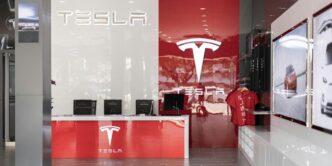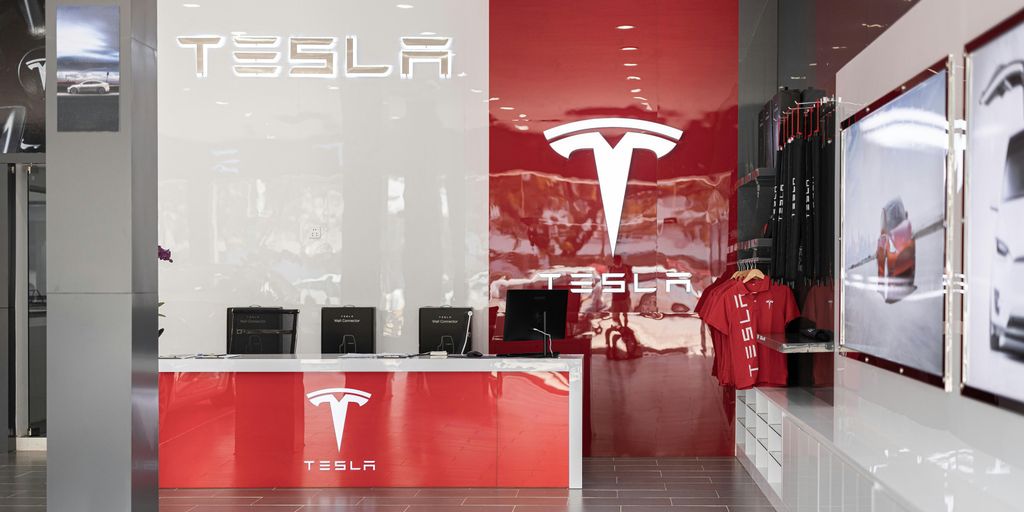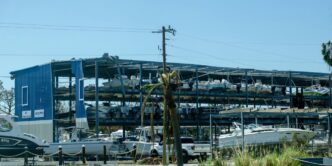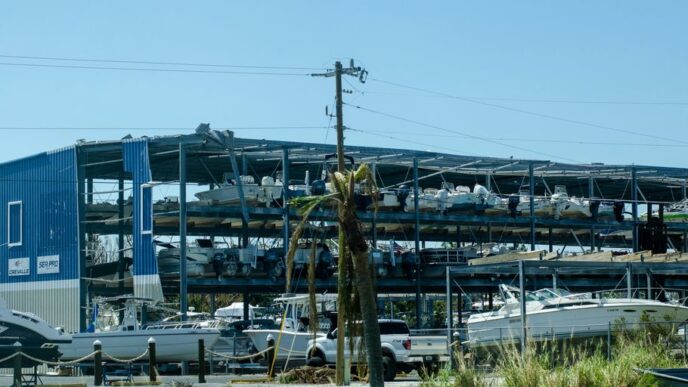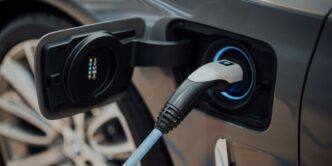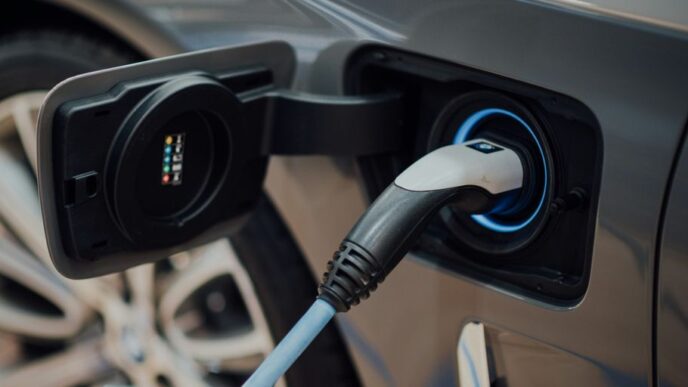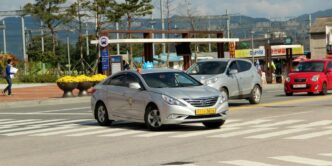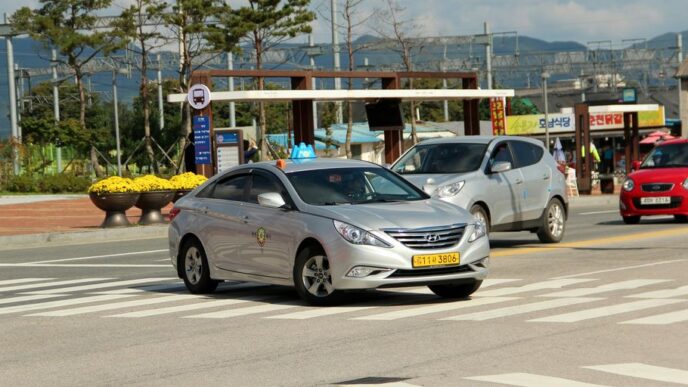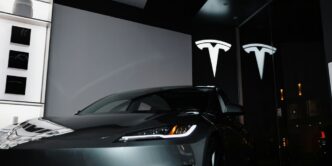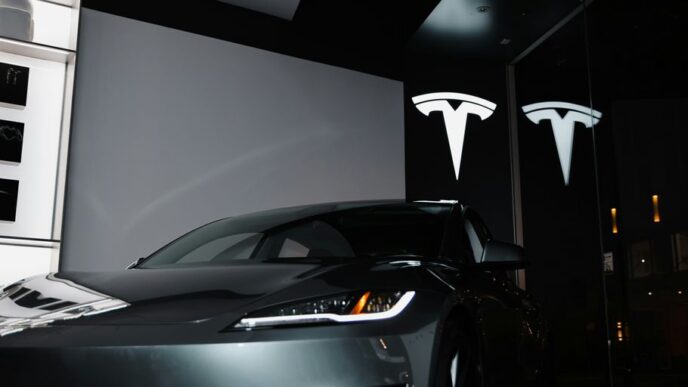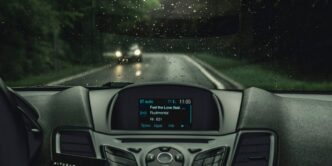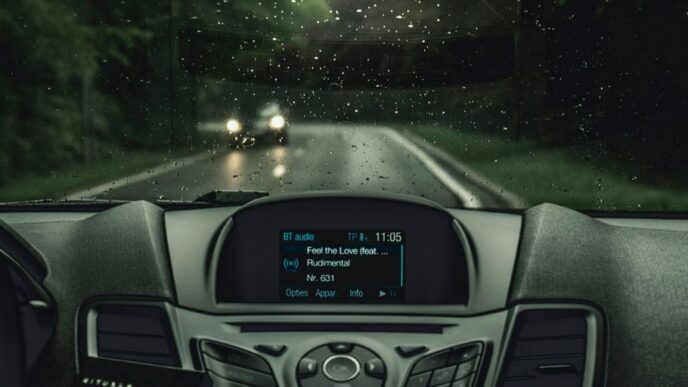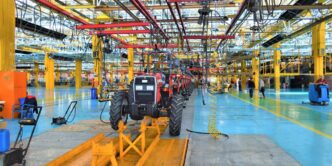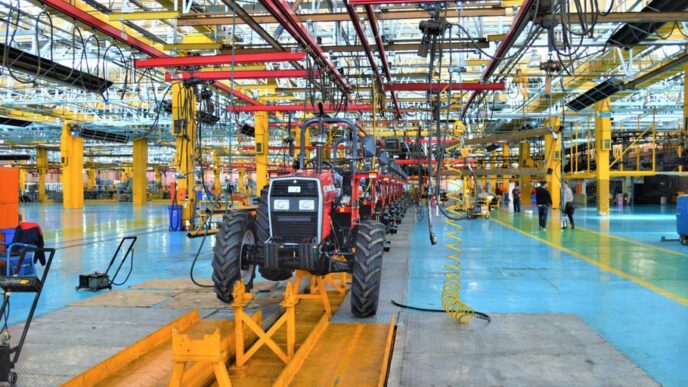So, Tesla is really pushing forward with its robotaxi plans, and guess what? Austin, Texas, is where it’s all happening. It looks like the company is getting super serious about launching these self-driving cars for public use. This whole thing isn’t just about making electric cars anymore; it’s about changing how we get around. Tesla’s big move into robotaxis, especially with the cool-looking Cybercab eventually, shows they’re thinking way ahead. It’s a pretty big deal for the future of transportation, and it’s all starting right there in Austin.
Key Takeaways
- Tesla is getting ready to launch its robotaxi service in Austin, Texas, with a target date of June 12 for initial rollout.
- The Cybercab, a car with no steering wheel or pedals, is a big part of Tesla’s long-term plan for self-driving transportation.
- Austin is a good spot for this because Texas has pretty easy rules for self-driving cars, unlike some other states.
- Tesla is trying to catch up to other companies already doing robotaxi services, like Waymo and Zoox, but they have their own challenges to deal with.
- This whole robotaxi project is the result of a lot of hard work over ten years from Tesla’s AI and chip design teams.
Tesla Austin Robotaxi Service Unveiled
Initial Rollout and Fleet Size
Tesla officially launched its robotaxi service in Austin on June 22nd, and it’s been a pretty big deal for Tesla fans. The initial rollout is, admittedly, a bit "low-key," as one analyst put it. Right now, it’s a small fleet of existing Tesla vehicles with a "robotaxi" logo on the side. It’s not the Cybercab yet, which is what everyone’s really waiting for. No official word on the exact number of vehicles in this initial phase, but it’s definitely a limited launch.
Targeted Launch Date
There was a lot of buzz around a potential launch date of June 12th, according to reports from late May. While that specific date didn’t pan out, it shows that Tesla was aiming for a mid-June launch. The actual launch happened a little later, but the intention was there. It seems like they were pushing hard to get the Austin Robotaxi Service up and running as quickly as possible.
Public Road Test Success
Before the official launch, there were reports of successful public road tests happening in Austin. These tests were crucial for gathering data and fine-tuning the self-driving software. While details are scarce, the fact that they moved forward with the launch suggests that the tests went well enough to meet Tesla’s internal standards. It’s a big step towards proving the viability of full self-driving in a real-world environment.
The Vision Behind Cybercab
Future of Autonomous Mobility
Tesla’s ambitions extend far beyond just making electric cars. The company sees a future where transportation is revolutionized by autonomous vehicles. This isn’t just about convenience; it’s about creating a safer, more efficient, and accessible transportation system for everyone. Tesla believes that self-driving technology will drastically reduce accidents, free up people’s time, and provide mobility solutions for those who can’t drive themselves. The robotaxi service is a key step in realizing this vision, and it’s a big bet on the future of how we get around. It’s a pretty bold move, but if it works, it could change everything.
Cybercab Concept and Design
The Cybercab is central to Tesla’s vision. This vehicle is designed from the ground up to be fully autonomous, meaning it won’t have a steering wheel or pedals. The idea is to maximize passenger space and create a comfortable, user-friendly experience. Think of it as a living room on wheels. The design prioritizes safety, efficiency, and accessibility. Tesla unveiled the Cybercab concept last year, and it’s definitely a departure from traditional car designs. It’s futuristic, minimalist, and designed to be a dedicated robotaxi. It’s a pretty radical concept, but it shows how serious Tesla is about this whole autonomous driving thing. The Cybercab is not yet part of the Austin rollout, but it’s coming.
Integration into Robotaxi Network
The Cybercab is designed to seamlessly integrate into Tesla’s robotaxi network. The plan is for users to be able to summon a Cybercab through the Tesla app, just like ordering a ride with Uber or Lyft. The vehicle will then autonomously navigate to the pickup location and transport the passenger to their destination. The network will be managed by Tesla’s AI, which will optimize routes, manage vehicle maintenance, and ensure safety. The goal is to create a reliable and affordable transportation option that’s available 24/7. It’s a pretty ambitious plan, but if Tesla can pull it off, it could disrupt the entire transportation industry. The current Austin pilot program uses existing Tesla vehicles, but the Cybercab is the ultimate goal. The Cybercab concept is pretty cool.
Why Austin is the Ideal Location
Austin, Texas, is quickly becoming a hub for technological innovation, and it’s no surprise that Tesla has chosen it as the launchpad for their robotaxi service. But why Austin? Let’s break it down.
Relaxed Regulatory Environment
One of the biggest draws to Austin is its relatively hands-off approach to autonomous vehicle testing and deployment. Unlike states with stricter regulations, Texas allows autonomous vehicles to operate under similar rules as human-driven cars. As long as they follow traffic laws, carry insurance, and have operational safety systems, they’re good to go. This makes it much easier and faster for companies like Tesla to get their technology on the road without jumping through endless regulatory hoops.
City of Austin Task Force
Austin isn’t just passively allowing autonomous vehicles; the city is actively encouraging them. The City of Austin has even created a task force specifically to work with AV operators like Tesla and Waymo. This collaborative approach helps smooth out any potential issues and ensures that the rollout of these technologies benefits the city and its residents. It’s a clear signal that Austin is open for business when it comes to the future of transportation.
Comparison to Other States
When you compare Austin to other states, the difference is pretty stark. Take California, for example. While it’s another tech hub, the regulatory environment for autonomous vehicles is much more complex and restrictive. This can slow down development and deployment, making Austin a more attractive option for companies looking to get their Cybercab services up and running quickly. The table below illustrates some key differences:
| Feature | Austin, Texas | California |
|---|---|---|
| Regulatory Environment | Relatively relaxed | More restrictive |
| City Support | Active task force | Varies by city |
| Speed of Deployment | Faster | Slower |
Austin’s welcoming attitude and proactive support make it the perfect place for Tesla to unveil the future of electric vehicles.
Competition in the Autonomous Vehicle Market
The autonomous vehicle market is heating up, and Tesla isn’t the only player. Several companies are vying for a piece of what could be a huge pie. It’s a race to see who can get reliable, safe, and affordable robotaxis on the road first.
Rival Robotaxi Operators
Tesla faces stiff competition from established players and ambitious startups. Waymo, owned by Alphabet (Google’s parent company), and Amazon’s Zoox already have self-driving taxi rides operating in Austin, as well as other cities like San Francisco and Phoenix. Uber is also getting into the game, partnering with companies like Pony.AI and WeRide to expand their autonomous ride-hailing services. These companies have been testing and refining their technology for years, giving them a head start in some areas.
Tesla’s Competitive Advantage
Tesla is betting big on its Full Self-Driving (FSD) software and the sheer volume of data it collects from its massive fleet of vehicles. The company believes its camera-based system is a cost-effective approach that will allow it to surpass its rivals. Tesla also has the advantage of brand recognition and a loyal customer base. If they can deliver a safe and reliable robotaxi service, many Tesla owners might be eager to give it a try.
Challenges and Safety Concerns
Despite the potential, there are significant challenges. Safety is paramount, and any accidents involving autonomous vehicles will draw intense scrutiny. Tesla’s FSD system has faced investigations and customer complaints regarding its safety. The technology needs to improve significantly to avoid the need for constant remote monitoring and intervention, which would add to costs and potentially create embarrassing situations. Public perception and regulatory hurdles also remain significant obstacles. It’s a long road ahead, and there’s no guarantee that Tesla will come out on top.
Technological Milestones and Development
Full Self-Driving Software
It’s easy to forget just how long Tesla has been working on full self-driving (FSD). It feels like it’s been "just around the corner" for years, but the progress is undeniable. The latest iterations of the FSD software are a huge leap forward. The system can now handle increasingly complex scenarios with minimal human intervention. It’s not perfect, of course, but the improvements are noticeable with each update. The team is constantly refining the algorithms, feeding it more data, and pushing the boundaries of what’s possible with autonomous driving. It’s a continuous learning process, and the robotaxi project is set to benefit from all of this hard work.
AI Chip and Software Teams
Tesla’s in-house AI chip development is a big deal. They aren’t relying on off-the-shelf solutions; they’re designing their own hardware specifically for the demands of autonomous driving. This gives them a huge advantage in terms of efficiency and performance. The AI team is massive, and they’re working on everything from perception to planning to control. It’s a full-stack approach, and it allows them to optimize every aspect of the system. The integration between the hardware and software is key to achieving true autonomy. The Gigafactory’s high-volume facility is a testament to Tesla’s commitment to vertical integration.
Decade of Hard Work
People often underestimate the sheer amount of effort that’s gone into this project. It’s not something that happened overnight. It’s been a decade of relentless development, testing, and refinement. There have been setbacks, sure, but the team has persevered. They’ve learned from their mistakes, and they’ve continued to push forward. The robotaxi is the culmination of all of that hard work. It’s a testament to Tesla’s vision and their commitment to innovation. It’s easy to be critical, but it’s important to recognize the scale of what they’re trying to achieve. The autonomous vehicle market is a tough one, but Tesla is definitely a frontrunner.
Here’s a quick look at the timeline:
- 2014: Initial Autopilot release
- 2016: Hardware 2 introduced
- 2019: Full Self-Driving preview
- 2024: Robotaxi prototype unveiled
- 2025: Limited Robotaxi launch in Austin
Operational Details and User Experience
Invite-Only Pilot Program
Okay, so here’s the deal with the initial rollout. Tesla isn’t just throwing the Cybercab keys to anyone. They’re starting with an invite-only pilot program. Think of it like a beta test, but with real cars and real roads. The idea is to get feedback from a select group of users before unleashing the robotaxis on the general public. This allows them to iron out any kinks, gather data on real-world usage, and refine the user experience. It’s all about making sure things run smoothly when the service goes live for everyone. This approach is similar to how they’ve rolled out other features in the past, like early access to full self-driving software for select drivers.
Flat Fee for Rides
Forget surge pricing and complicated fare calculations. Tesla is keeping it simple with a flat fee for rides. This is a pretty big deal because it makes budgeting for transportation way easier. No more guessing how much your trip will cost based on traffic or time of day. Just a straightforward, predictable price. It’s a move that could really appeal to people who are tired of the unpredictable costs associated with ride-sharing services. I think this is a smart move to attract users. Here’s a quick comparison of potential pricing models:
| Pricing Model | Pros | Cons |
|---|---|---|
| Flat Fee | Predictable, easy to budget | May not be optimal for short trips |
| Surge Pricing | Adapts to demand | Can be expensive and unpredictable |
| Metered Fare | Fair for varying distances | Can be confusing and less transparent |
Safety Operator Presence
Even though these are supposed to be autonomous vehicles, Tesla is taking a cautious approach to safety. During the initial phases, a safety operator will be present in the vehicle. This person is there to monitor the system, take control if necessary, and ensure the safety of the passengers and other road users. It’s a safety net, plain and simple. It also helps build public trust in the technology. Over time, as the system proves its reliability, the role of the safety operator may evolve, but for now, they’re a crucial part of the Cybercab concept and design. Here are some reasons why a safety operator is important:
- Ensures passenger safety during unexpected situations.
- Provides a human override in case of system malfunction.
- Gathers data on system performance and identifies areas for improvement.
- Helps build public confidence in autonomous vehicle technology.
Scaling and Future Expansion
Plans for Thousands of Vehicles
Okay, so the invite-only pilot program is cool and all, but what’s next? The big picture involves a whole lot more Cybercabs cruising around Austin. We’re talking thousands. The idea is to ramp up production and deployment significantly over the next few years. Tesla’s aiming for a substantial fleet to really make an impact on transportation in the city. Think about it: fewer privately owned cars, less traffic, and a greener Austin. It’s a pretty ambitious goal, but if anyone can pull it off, it’s probably Tesla. The Giga Texas production facility is already churning out vehicles, so scaling up robotaxi production seems like the next logical step.
Broader Public Rollout
Once the initial fleet is up and running smoothly, the plan is to open up the robotaxi service to the general public. No more invite-only exclusivity! This means anyone with the Tesla app will be able to hail a Cybercab and get around town. The timeline for this broader rollout is still a bit hazy, but it’s expected to happen in phases. First, expanding within Austin, and then potentially to other cities. It’s all about proving the technology is safe and reliable before going full-scale. Imagine a future where you don’t even need to own a car to get around. That’s the dream, anyway.
Regulatory Permissions
Of course, none of this happens without getting the green light from regulators. Autonomous vehicles are still a relatively new thing, and there are a lot of rules and regulations that need to be sorted out. Tesla’s working closely with city and state officials to ensure the Cybercabs meet all safety requirements. This includes things like data collection, accident reporting, and emergency protocols. It’s a complex process, but getting these regulatory permissions is essential for the long-term success of the robotaxi service. It’s not just about the technology; it’s about building trust with the public and ensuring everyone’s safety.
Wrapping Things Up: What This Means for Tesla and Beyond
So, what’s the big takeaway from all this Austin robotaxi stuff? Well, it’s pretty clear that Tesla isn’t just about making cool electric cars anymore. They’re really pushing hard into self-driving tech, and Austin is like their big testing ground. It’s a bold move, especially with other companies already out there doing similar things. Whether Tesla can really pull ahead and make their driverless cars a common sight on our roads, that’s still up in the air. There are a lot of things that need to go right, like making sure the tech is super safe and getting all the rules sorted out. But one thing’s for sure: the future of getting around is changing fast, and Tesla’s right in the middle of it all, trying to make their mark.
Frequently Asked Questions
Where is Tesla launching its robotaxi service?
Tesla’s robotaxi service is starting in Austin, Texas. The company picked Austin because Texas has easier rules for self-driving cars compared to other states.
What kind of cars will Tesla use for the robotaxi service?
Tesla is using regular Model Y cars for now, but they plan to use a special car called the Cybercab later. The Cybercab won’t have a steering wheel or pedals.
Who can use the Tesla robotaxi service at first?
The service will begin with a small group of invited people. Later, it will be available to more people as Tesla gets more cars ready and gets more approvals.
Will there be a person inside the robotaxi?
Yes, for now, there will be a safety driver in the passenger seat of the robotaxis. This person is there to take over if the car has trouble driving itself.
How much will a ride in a Tesla robotaxi cost?
Tesla’s robotaxis will cost a flat fee of $4.20 per ride. This price might change as the service grows.
How many robotaxis does Tesla plan to have?
Tesla wants to have thousands of robotaxis on the road in the coming months. They hope to make self-driving cars a big part of their business in the future.

